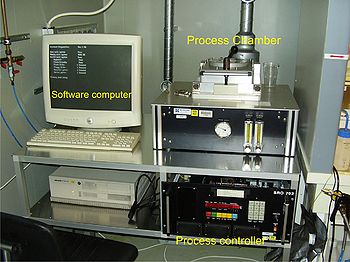Specific Process Knowledge/Thermal Process/BCB Curing Oven: Difference between revisions
No edit summary |
mNo edit summary |
||
| Line 1: | Line 1: | ||
'''Feedback to this page''': '''[mailto:labadviser@danchip.dtu.dk?Subject=Feed%20back%20from%20page%20http://labadviser.danchip.dtu.dk/index.php/Specific_Process_Knowledge//Thermal_Process/BCB_Curing_Oven click here]''' | |||
== BCB Curing Oven == | == BCB Curing Oven == | ||
Revision as of 15:27, 4 October 2013
Feedback to this page: click here
BCB Curing Oven
The BCB Curing Oven is mainly used for curing of BCB (bisbenzocyclobutene) and for alloying of metals in a nitrogen atmosphere.
During processing the furnace is rapidly heated by use of eight halogen lamps situated below the sample. The furnace is purged with a high or a low nitrogen flow. Samples are processed at atmospheric pressure or at vacuum.
The user manual, user APV, technical information and contact information can be found in LabManager:
Process information
Here are some of the standard processes used in the BCB Curing Oven.
BCB curing:
- Long curing at 210°C: BCB210AL.PDF/File:BCB210BL.PDF
- Long curing at 250°C: BCB250AL.PDF/File:BCB250BL.PDF
The AL/BL processes are (should be) identical except for a (2x) pump/purge cycle in the beginning of the BL processes.
General processes
There are a number of general processes named DxxxCyyy.PDF.
The Dxxx is the set temperature (in °C) and the Cyyy is the time (in minutes) at the set temperature.
The oven heats to the set temperature (xxx) in 5 mins and then stays at the temperature (xxx) for a time (yyy) after which it cools to room temperature as fast as possible.
The program sequence looks like this for the file D200C060.PDF:
;
; stored 31.08.2011 at 18:15:47
{P0}
00,05:00,0200,H - - 2 - - - - -,075,250,001,005,028
01,60:00,0200,H C 1 - - - - - -
02,05:00,0002,- C 1 - - - - - -
03,00:00,0000,- C - - - - - - -
| Equipment | BCB Curing Oven | |
|---|---|---|
| Purpose |
| |
| Process parameter range | Temperature |
|
| Nitrogen flows |
| |
| Pressure |
| |
| Substrates
(Remember to use the right carrier wafer) |
Batch size |
|
| Allowed materials |
| |
